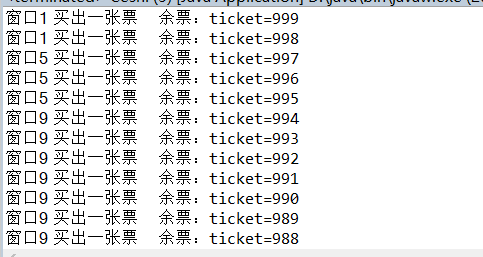第九周课程总结&实验报告(七)
课程总结
这周我们学习了多线程和一点点关于文件的输入与输出。
线程
线程共分为两大类 继承Thread 以及 实现Runnable接口。
取得线程名称:Thread。curentThread().getNane()
判断线程是否启动 isAlive();
线程强制运行 join();
后台线程 setDaemon();
最高级 MAX—PRIORITY
线程的优先级 最高级 NORM—PRIORITY
最低级 MIN—PRIORITY
线程的礼让 yield()
同步代码块
synchronized(同步对象){ ///synchronized(this)this表示当前对象
需要同步的代码块;
}
同步方法
synchronized 方法返回值 方法名称(参数列表){
方法体
}
操作文件的类File
使用RandonAcccessFile类写入数据
实验报告
实验任务详情:
完成火车站售票程序的模拟。
要求:
(1)总票数1000张;
(2)10个窗口同时开始卖票;
(3)卖票过程延时1秒钟;
(4)不能出现一票多卖或卖出负数号票的情况。
代码
实现Runnable接口类
package test12;
public class MyThread implements Runnable {
private int ticket = 1000;
public void run() {
for (int i = 1; i <= 1000; i++) {
synchronized (this) {
if(ticket==0) {
System.out.println(Thread.currentThread().getName() + "票已售完!");
break;
}
if (ticket > 0) {
ticket--;
try {
Thread.sleep(0);
} catch (InterruptedException e) {
e.printStackTrace();
}
System.out.println(Thread.currentThread().getName() + " 买出一张票 余票:ticket=" + ticket);
}
}
}
}
};
测试类
package test12;
public class Ceshi {
public static void main(String[] args) {
MyThread mt = new MyThread();
new Thread(mt, "窗口1").start();
new Thread(mt, "窗口2").start();
new Thread(mt, "窗口3").start();
new Thread(mt, "窗口4").start();
new Thread(mt, "窗口5").start();
new Thread(mt, "窗口6").start();
new Thread(mt, "窗口7").start();
new Thread(mt, "窗口8").start();
new Thread(mt, "窗口9").start();
new Thread(mt, "窗口10").start();
}
}
运行截图





